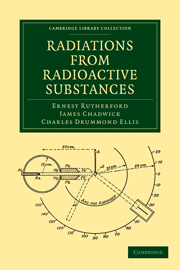Book contents
- Frontmatter
- Contents
- LIST OF PLATES
- Preface
- Chap. I Radioactive Transformations
- Chap. II The α Rays
- Chap. III Absorption of the α Rays
- Chap. IV Some Properties of the α Particle
- Chap. V Theories of Absorption of α Rays
- Chap. VI Secondary Effects produced by α Rays
- Chap. VII General Properties of the Radiations
- Chap. VIII The Scattering of α and β Particles
- Chap. IX The Collisions of α Particles with Light Atoms
- Chap. X The Artificial Disintegration of the Light Elements
- Chap. XI The Radioactive Nuclei
- Chap. XII β Ray and γ Ray Spectra
- Chap. XIII The Disintegration Electrons
- Chap. XIV The Passage of β Particles through Matter
- Chap. XV The Scattering and Absorption of γ Rays
- Chap. XVI Intensity Problems connected with the Emission of γ Rays
- Chap. XVII Atomic Nuclei
- Chap. XVIII Miscellaneous
- Appendix
- Subject Index
- Index of Names
- Plate section
Chap. III - Absorption of the α Rays
Published online by Cambridge University Press: 07 September 2010
- Frontmatter
- Contents
- LIST OF PLATES
- Preface
- Chap. I Radioactive Transformations
- Chap. II The α Rays
- Chap. III Absorption of the α Rays
- Chap. IV Some Properties of the α Particle
- Chap. V Theories of Absorption of α Rays
- Chap. VI Secondary Effects produced by α Rays
- Chap. VII General Properties of the Radiations
- Chap. VIII The Scattering of α and β Particles
- Chap. IX The Collisions of α Particles with Light Atoms
- Chap. X The Artificial Disintegration of the Light Elements
- Chap. XI The Radioactive Nuclei
- Chap. XII β Ray and γ Ray Spectra
- Chap. XIII The Disintegration Electrons
- Chap. XIV The Passage of β Particles through Matter
- Chap. XV The Scattering and Absorption of γ Rays
- Chap. XVI Intensity Problems connected with the Emission of γ Rays
- Chap. XVII Atomic Nuclei
- Chap. XVIII Miscellaneous
- Appendix
- Subject Index
- Index of Names
- Plate section
Summary
§ 15. Absorption of α rays. Historical. The absorption of α rays by matter was first investigated by Rutherford in 1899 by the electric method. A layer of radioactive material was spread on a plate and the variation of the saturation current between this plate and another placed parallel to it was examined by an electrometer when successive screens of absorbing matter were placed over the active matter. The current was found at first to decrease approximately according to an exponential law with the thickness of matter traversed, but ultimately fell off more slowly. Experiments of this kind were first made with uranium, and led to the divisions of the radiation into two types, called the α and β rays. Observations by similar methods showed also that the α rays were rapidly absorbed in air and other gases. Many experiments of this kind were made in the early days of radioactivity by Owens, Rutherford and Miss Brooks, Meyer and Schweidler and others.
When more active materials were available, it was possible to obtain easily measurable effects with a definite pencil of α rays. Mme Curie examined the absorption of the α rays from a thin film of polonium by a different method. The rays from polonium passed through a circular opening in a metal plate covered with a wire gauze or a thin metal foil, and the ionisation of the rays, after passing through the hole, was measured between this plate and a plate placed 3 cm. above it.
- Type
- Chapter
- Information
- Radiations from Radioactive Substances , pp. 67 - 100Publisher: Cambridge University PressPrint publication year: 2010First published in: 1930



